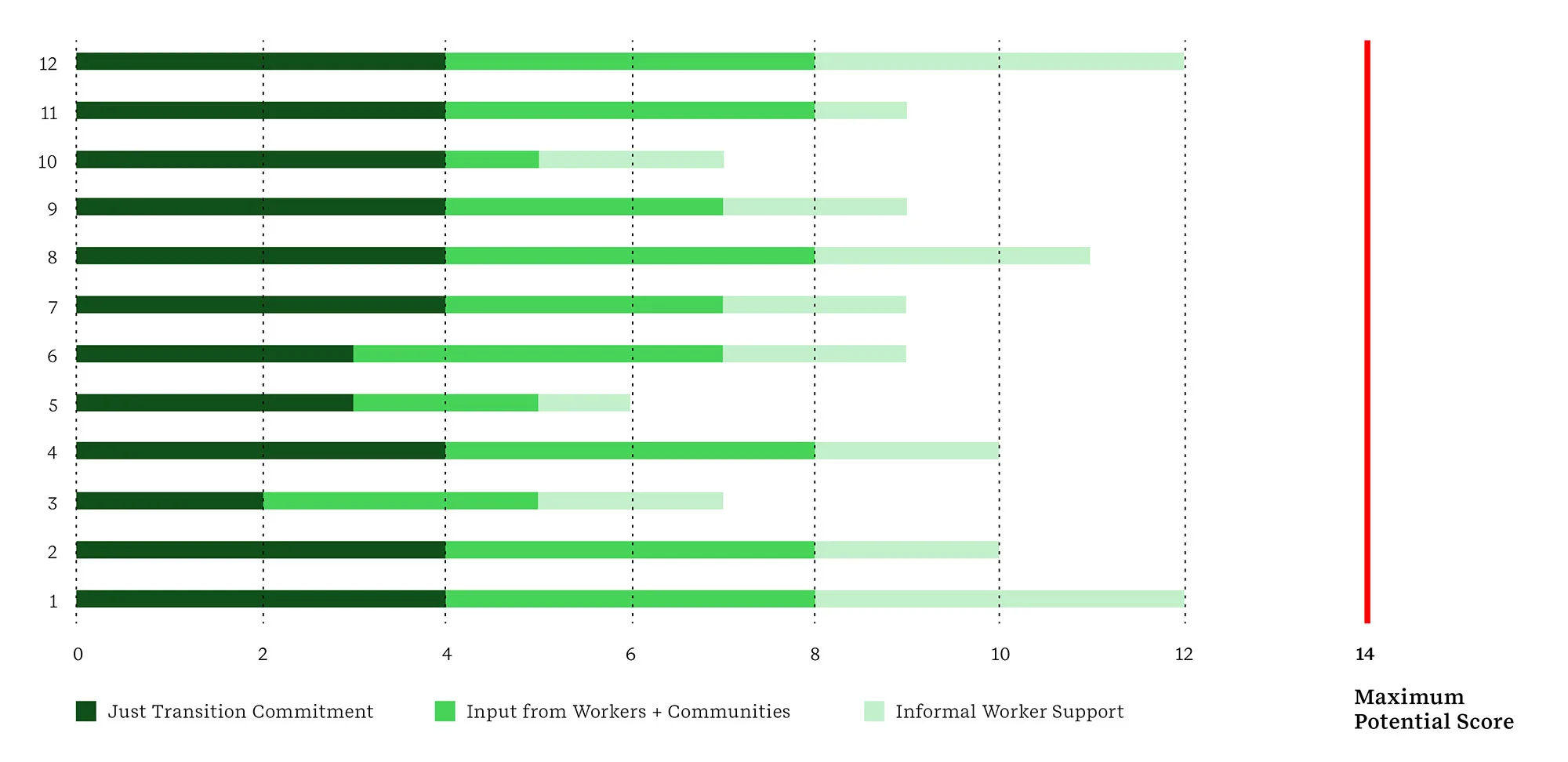Authors
Sofia Nazalya - ERM, Surbhi Singhvi - WBCSD
- In the shift to a low-carbon economy, Just Transition planning is well on its way in Asia, but a thorough assessment of the impact on the workforce and communities is nascent across companies surveyed
- Stakeholder engagement and tracking performance of workforce transformation efforts are fragmented; action happens on a case-by-case basis
- Informal sector workers – defined here as those who lack legal protection and regulation as they are not sufficiently covered by formal arrangements recognized under law – in the supply chain are mostly excluded from corporate transition planning
Asia, accounting for more than half of the globally installed renewable power capacity as of 2024, is at the forefront of the global energy transition. The region is key in ensuring a just, inclusive and effective energy transition globally. While rapid progress on renewable power deployment has been made in the region, challenges remain. These include continued dependence on fossil fuels, techno-commercial constraints, and lack of adequate grid interconnection and infrastructure. Ensuring that the energy transition is just and inclusive is seen by many as an additional layer of complexity.
At the heart of the Just Transition is the advancement of decent work, job creation and equitable outcomes for all. Integrating these priorities into energy transition plans of businesses ensures that human rights principles are embedded in the planning process from the start. It positions rightsholders to be key enablers in the shift to a low-carbon economy. This is only made possible if companies proactively assess implications from the energy transition on the workforce and communities and take decisive action ensuring that people are not left worse off. “Coal has historically supported livelihoods; any move to renewables has to respect that”, a C-suite professional from India Power noted.
| Just Transition: Workforce Transformation Asia SAQ To understand the state of the Just Energy Transition in Asia, WBCSD and ERM collaboratively undertook a survey/self-assessment questionnaire (SAQ) for WBCSD members and ERM clients with operations in the region. The survey consisted of 32 questions on the themes of Energy Transition journey, Stakeholder Engagement and Social Dialogue, Workforce and Community Transformation, Commitment and Governance and Just Transition Planning and Progress Tracking. A total of 12 companies representing energy utilities, hard-to-abate sectors and diversified energy generators based in APAC or with sizable presence in the region responded to the survey. Follow-up interviews were conducted with five companies to obtain in-depth insights into their Just Transition journey. Given the limited sample size of the SAQ, insights derived from quantitative analysis should not be treated as broadly representative. They intend to provide initial insights into the state of play of Just Transition across Asia. |
Building blocks are in place for a Just Transition, but gaps remain on structured action
The commitment to Just Energy Transition amongst the companies surveyed came out clearly. Nine out of 12 surveyed companies described a clear commitment, aligned with broader corporate and sustainability goals, with concrete actions and initiatives underway. This also reflects across the region through progressive intra-regional initiatives such as the ASEAN Leaders for Just Energy Transition (ASEAN JET), a CEO-led community of 31 companies from across the region, working collectively towards enabling a just energy transition.
However, companies are still a long way off from embedding just transition plans into their operations in a consolidated and structured manner. Efforts to assess potential impact of the transition on workers and communities, which is a fundamental part of putting in place a robust just transition plan, have mostly been fragmented. Companies also find it difficult to implement an overarching, corporate-level Just Transition plan in the context of different geographic locations with varying local challenges, skill sets, policy environment and financial support.
Lack of structured stakeholder engagement increases social risks
One of the core principles of Just Transition is meaningful engagement with affected stakeholders. Most surveyed companies have identified key stakeholders who will be affected by the energy transition. However, most companies remained short of fully mapping stakeholders based on underlying vulnerabilities and consequently engaging in meaningful dialogue to collectively come up with strategies to address their concerns.
Commitment Implementation gap a key challenge for corporate transition plans

Stacked bars show each of the 12 companies’ scores for (i) overall commitment (dark green), (ii) gathering structured input from workers and communities (mid-green) and (iii) providing planned support for informal workers (light green). Bar length indicates the combined total out of a potential maximum score of 14.
The visual above outlines the individual responses demonstrating a visible gap when it comes to translating “commitment to Just Transition” into actual stakeholder engagement and planned support. Nine companies begin with a high commitment score, indicating that feedback from these stakeholders is considered critical. However, only six conduct “regular and structured engagement” with workers and local communities, while the other six cluster at the lower tiers that denote ad-hoc or infrequent consultations.
Although most surveyed companies have successfully established strategic intent, the development of people-centered architecture—such as evaluating stakeholder impacts, implementing structured consultations, creating reskilling pathways, and allocating social protection budgets—is still a work in progress. Nonetheless, some businesses in the region have demonstrated leadership in these areas. ACEN’s Just Energy Transition (JET) roadmap, for example, clearly signals stakeholder engagement as a priority, with community transition and worker reskilling and redeployment amongst its key pillars. Another example is Tata Power’s TP Renewable Microgrid, where detailed workforce assessments were conducted, identifying training needs and redeployment opportunities for existing employees. Such efforts pave the way for putting people at the heart of the energy transition in the region.
One of the key barriers highlighted by companies for slow progress was insufficient funding for people-centric efforts in the financing of transition projects. This was also reflected in a joint study by AVPN and BCG that found insufficient funding allocation for “People-centric levers” in transition financing initiatives.
Clear recognition of corporate responsibility, with lack of alignment on its scope
SAQ results show encouraging early action by some companies to support affected workers but also reveal differing views on the extent of responsibility companies should assume for those potentially facing retrenchment during the energy transition. Seven out of 12 companies recognize their responsibility to support affected workers, with at least two companies offering a comprehensive system of re/upskilling, career transition services, and social protection measures. Companies who acknowledge greater responsibility to support affected workers were generally found to have also taken corresponding steps to ensure workforce transition efforts that consider equal access to and inclusiveness of reskilling programs and green jobs.
Informal sector workers appear to be the most vulnerable workforce category. Nine companies responded that they either had no plans to provide support to informal workers (one company), or recognized their vulnerability, but had no formal strategy to support them (eight companies). Two of the companies surveyed reported ongoing engagement with this group. The exclusion of informal workers from most transition plans exposes them to greater risks of sudden income loss and skills obsolescence as carbon-intensive assets are retired. Considering that the informal workforce represents 66% of total employment in the region, chances are that many corporate transition plans may fall short of capturing or acting on impacts on a sizable portion of the region’s workforce.
Inadequate policy support from the government was cited as a major barrier by six out of 12 companies and the majority also blamed insufficient data or insights to guide decision making on workforce transformation. A third of companies (four) collaborate with government entities on social protection measures for at least some affected stakeholders.
Way forward on workforce transformation
Recognition of the importance of Just Transition and the need to embed the same into corporate energy transition considerations in Asia is clear. However, pathways to convert commitments into credible and inclusive interventions are still evolving.
ERM’s ‘Embedding Just Transition into Corporate Climate Action Strategies’ report, issued in September 2024, as a contribution to the goals of the Business Commission for Tackling Inequality (BCTI), a WBCSD initiative, provides actionable guidance for companies on how to operationalize the Just Transition, including workforce and community considerations.
While there is no one-size-fits-all solution, the following step-by-step actions could support development of a robust Just Transition plan.
- Assess workforce and community needs: A good starting point is to conduct impact assessments to identify potential redundancies and map specific skillsets required for affected workforce. Assessing impacts for the affected communities should also be done in tandem to ensure an all-inclusive approach.
- Adopt a vulnerability lens to stakeholder mapping: Vulnerable groups, such as the informal workforce, youth, women, workers in rural areas, indigenous people, amongst others, are often left out of corporate transition plans. Understanding impact of transition plans on these groups will help prioritize actions and minimize social risks for the business.
- Engage in intentional and meaningful stakeholder engagement: Consider building engagements that are equitable and accessible to stakeholders and integrate their feedback into corporate transition planning. Conducting continuous engagement through dedicated channels and tailored programs, implementing tangible actions to address their concerns, and establishing measurable positive outcomes are some key steps to consider.
Given the challenges faced in Asia, the above-mentioned steps are aimed at ensuring a solid start to companies on their just transition journeys. It must be noted that collaboration remains key to effective implementation. Since Just Transition is tied both to business and social objectives, a close collaboration between policymakers and businesses on the subject is essential to ensure achieving dual goals in a balanced manner. A sustainability professional from JSW Group noted, ‘Just Transition is essential to ensure that no one is left behind. With a clear direction from the regulators through a mix of policies and energy transition roadmaps, businesses will be able to effectively contribute to the larger social objective.’ Collaborating on workforce transformation efforts amongst the industry players – financial institutions, sector peers and cross-sector stakeholders- is equally important to benefit from a common resource pool and shorten the learning curves. In short, a system’s approach is very much needed to ensure an inclusive and effective energy transition for companies and countries.
This article has benefited from contributions from Ian Reilly, ERM and Wouter van Monsjou, WBCSD.
Outline
